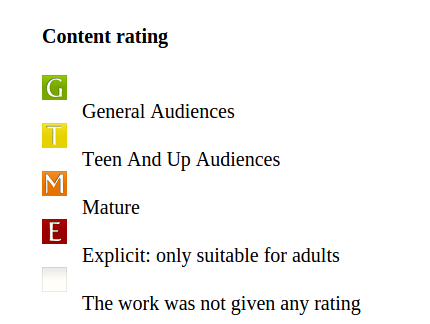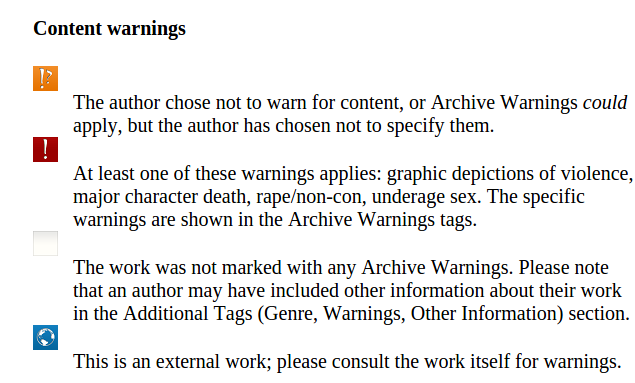A couple of weeks ago, there was a discussion on The Passive Voice blog about trigger warnings and how they are destroying literature. The post spawned a discussion that went on for 240 comments before Passive Guy closed it (probably because we got too political), but it ended up being very insightful.
Laying aside any issues of politics social justice, the fact exists that there is simply not a standard content rating system for books. We have rating systems for movies (MPAA is the main one here in the US) and video games (ESRB), but the majority of books are published without any sort of rating at all.
Is this a bad thing? Personally, I don’t think so, but I know that it matters to others. Last year, there was a big kerfluffle in the book world over an app called Clean Reader that screened objectionable content based on a number of user-controlled filters. It seems that there is an unmet need for some sort of system to help readers avoid offensive content.
That was why the discussion on TPV was so fascinating to me. Between the cries of “censorship!” and “triggering!” there were some very interesting points brought up. Yes, there are politically-motivated people who use “trigger warnings” as a means of advancing the political correctness regime, but there are also sensative readers who appreciate that sort of thing. When I first published Bringing Stella Home, I put a warning on it that stated “if this were a movie, it would be rated PG-13,” and at least one reviewer really appreciated that.
It’s a little bit ridiculous to equate trigger warnings with censorship, though both may be found on the same slippery slope. Still, there are places that scan your metadata and block you from publishing based not on the actual content, but your description of the content. Erotica writers know far more about navigating this maze than I do, though I have experienced it with books like Sholpan. Ironically, adding a content warning to the book description can sometimes get your book blocked altogether, even though the content is far tamer than some of the books on the site from traditional publishers.
So what’s an indie author to do? The commenters at TPV mentioned a site called AO3, or Archive of Our Own, as a place to check out. It’s a massive repository of fanfiction with a very refined system of filters and tags, along with a rating system that seems to work really well.
Since I really don’t want to reinvent the square wheel, I decided to check it out and see if this was the sort of thing I could apply to my own original books. I’ve never been a big reader of fanfiction, but I know that many of my readers are, so adapting the AO3 system seemed like a good way to present them with a system that felt intuitive and familiar.
The AO3 content ratings system has four components: content ratings, pairings/orientations, content warnings, and finished/unfinished. Obviously, the last one really doesn’t apply, since anything I publish commercially is going to be a finished work. The pairings/orientations component also seems unnecessary, since in a book where romance is a major plot driver, the reader should be able to gather from the book description whether it’s M/F, M/M, F/F, or whatever. Also, fanfic readers tend to read for that sort of thing, while general readers do not.
That means that the relevant part of the system is the content rating and the content warnings. I looked for a more detailed official explanation, but it really does seem like ultimate discretion is left to the writers.
 There are four countent ratings: G, T, M, and E. If you’re more familiar with AO3 than I am, please correct me if I’m wrong, but it seems that the equivalent MPAA ratings are as follows:
There are four countent ratings: G, T, M, and E. If you’re more familiar with AO3 than I am, please correct me if I’m wrong, but it seems that the equivalent MPAA ratings are as follows:
- G: General Audiences.
- T: PG and PG-13.
- M: Restricted.
- E: NC-17.
Of course, it’s virtually impossible to avoid some degree of subjectivity with these sorts of things. What is the threshold between a T and an M? I’m not sure, but I think it lies somewhere between an implied sex scene and one that describes the actual act, or violence that advances thea plot versus violence that IS the plot. There’s also the threshold between an M and an E, but I’m less concerned about that because my books don’t tend to be that extreme.
The key part of the AO3 system, which also removes a great deal of ambiguity, is the content warnings:
 The key part here is the ! tag, since the last two obviously don’t apply and the ?! tag is too purposefully ambiguous to be useful. The ! tag very clearly states that one of the following things will be true:
The key part here is the ! tag, since the last two obviously don’t apply and the ?! tag is too purposefully ambiguous to be useful. The ! tag very clearly states that one of the following things will be true:
- A major character will die, OR
- The descriptions of violence will be graphic, OR
- There will be rape or non-consensual sex, OR
- The sex will involve minors.
In other words, the ! tag indicates a trigger warning. A book rated T, for example, may have some non-triggering crude or obscene language, but a book rated T! is going to have something that would trigger, say, a rape victim, or a victim of child abuse. Obviously, some readers won’t be triggered as much as others, but adding a warning tag makes it easier for readers to use their own discretion.
Again, correct me if I’m wrong, but I think that this is the best way to adapt the AO3 system. Towards that end, I’ve added a rating to all of my books, so that if you’re familiar with the AO3 content rating system, you should be able to tell pretty easily where each of my books rate. Unless something drastic changes, I expect to use this system to rate all my books in the future.
Am currently reading my first book by Joe Vasicek, Genesis Earth, and have added him to my list of favorite authors. This article underscores my reasoning. A open-minded and thorough analysis of book ratings that is quite easily understood. It illustrates the care you have for your readers!